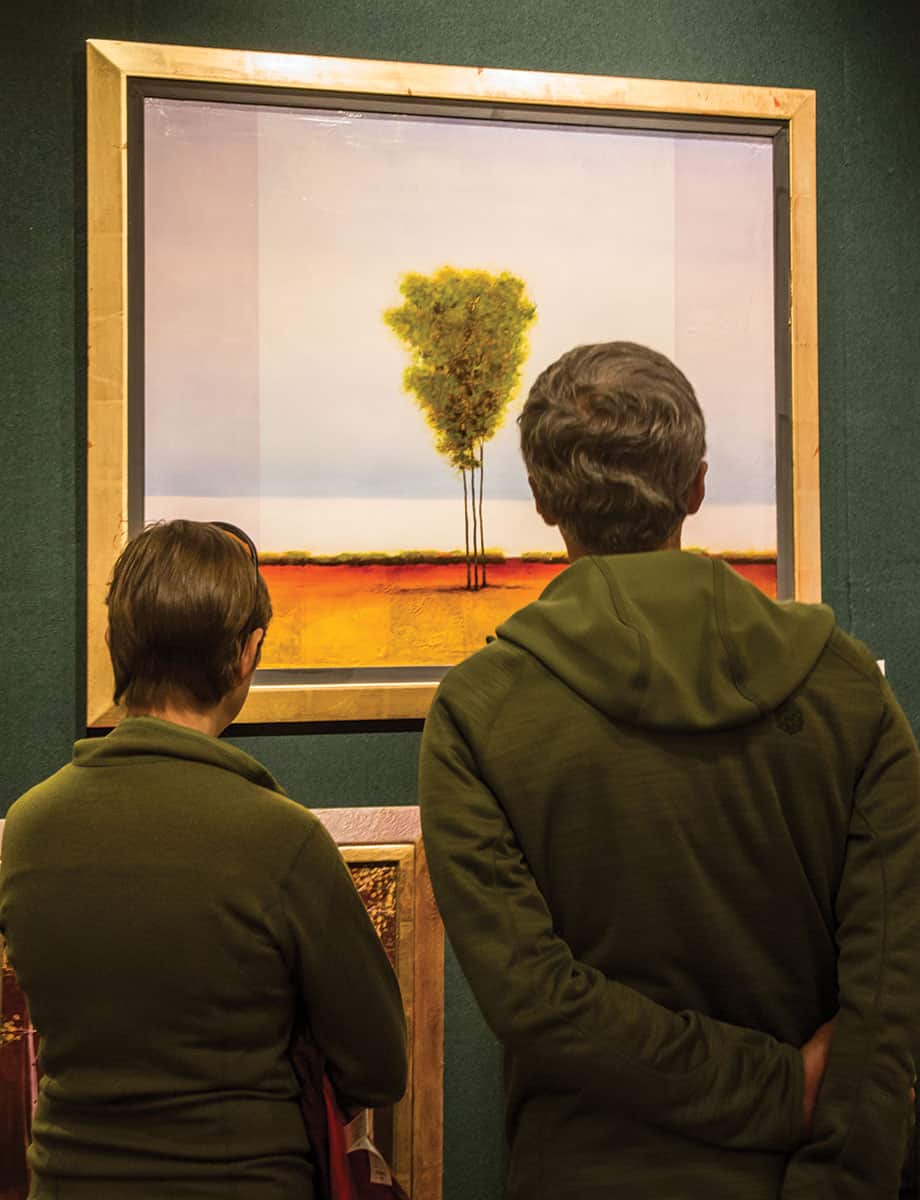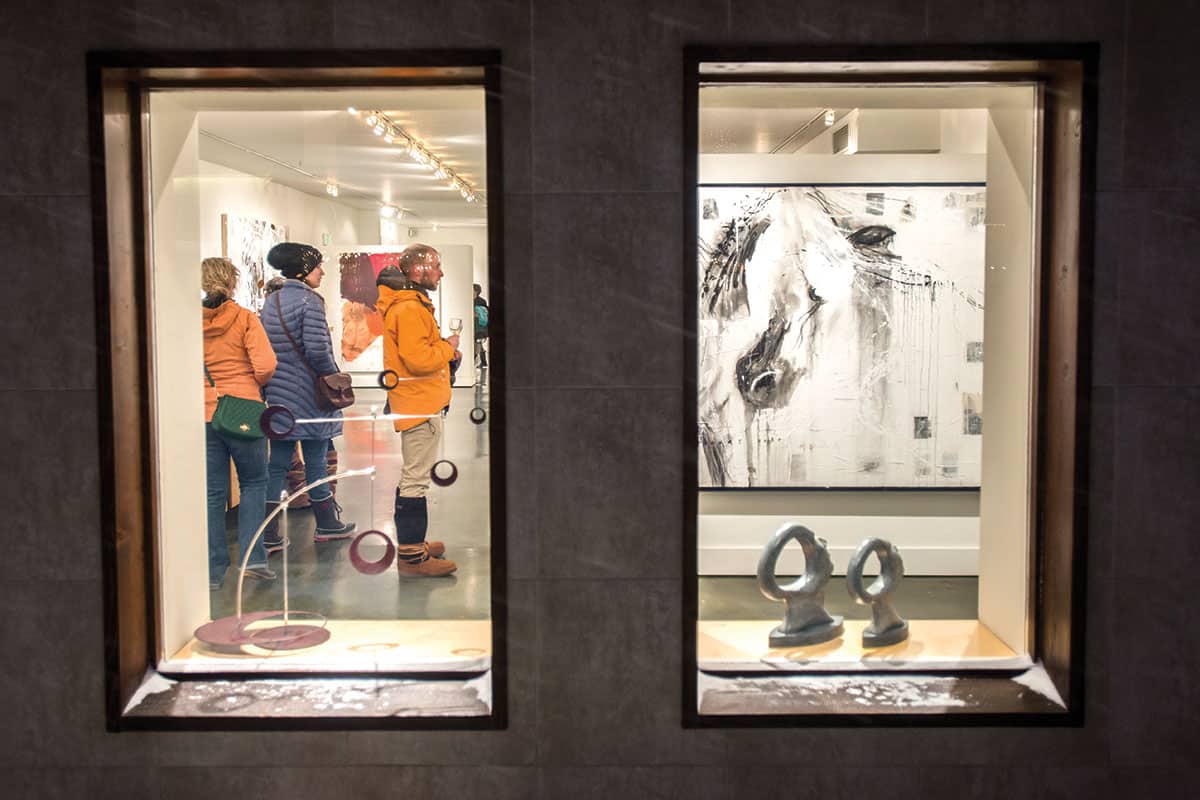Read The
Current Issue
VibrART
Explore one of the country’s most vibrant art communities.
By Lila Edythe

JACKSON HOLE HAS one of the most vibrant art scenes in the country. Since the National Center for Arts Research began measuring arts vibrancy in every U.S. county in 2015, we’ve rated in the index’s top 10 for small to medium-size cities. In 2016, Jackson Hole even ranked No. 1, ahead of Glenwood Springs, Colorado; Santa Fe, New Mexico; Breckenridge, Colorado; and Edwards, Colorado. The index, on a per capita basis, measures supply, demand, and public support for arts and culture.
“It is wonderful to see Jackson being nationally recognized,” says Lyndsay McCandless, executive director of the Center of Wonder, a local, collaborative nonprofit that supports programs that invoke a sense of wonder and inspire creativity in participants. “We have painters, musicians, filmmakers, dancers, and all kinds of creative thinkers living and creating here. It is the people here in Jackson that help bring us such incredible art experiences every day.”
As impressive as it is to receive these top-10 rankings, experiencing the vibrancy behind them is more so. Shari Brownfield, a fine art appraiser and consultant who founded Shari Brownfield Fine Art in 2015 and previously worked in galleries in the U.S. and Canada, says she—and her guests and clients—never fail to be impressed by the amount of art offerings. “I’m not just talking about visual arts,” she says. “But also performing arts, theater, dance, literature, and music.” Brownfield, who is the board chair of the Center of Wonder and on the board of the Art Association of Jackson Hole, says a problem she had in the recent past was that Jackson had so many art events going on that she couldn’t keep track of them all. “Even the newspapers had difficulties tracking all of the various events,” she says.
This problem has been solved, though. In September 2016, the Center of Wonder launched DailyWonder.org, an online arts calendar that lists and describes every art-related activity happening on any given day. Listings for a recent day ranged from an open ceramics studio at the Art Association of Jackson Hole to Knit Night; the opening reception for Weaving an Adventure: Works by Doris Florig at Teton County Library; an open studio and artist talk at Teton Artlab; Tasha and the Goodfellows singing at The Silver Dollar Bar; and a performance of The Unsinkable Molly Brown at the Jackson Hole Playhouse. These were only about half of the day’s events.
THE HISTORY OF Jackson Hole’s art scene lies in visual arts, and visual arts are its single largest component. Jackson Hole has more art galleries per capita than most anywhere else in the country. At last count there were thirty galleries; twenty-eight of these are members of the Jackson Hole Gallery Association.
“Many people do not realize what a rich history this valley has in terms of attracting artists to paint the dramatic landscapes and the incredible wildlife of this area,” says Maryvonne Leshe, managing partner of Trailside Galleries, the valley’s oldest gallery that has since expanded to a second location in Scottsdale, Arizona. Brownfield adds, “This is where [Thomas] Moran painted. There is a history that goes along with art in the Rocky Mountain West.”
It was a natural progression from artists coming here to paint the area’s landscapes and wildlife to galleries opening to sell the works of these artists and of others painting similar subjects. When Dick Flood opened Trailside Galleries on the Town Square in 1963, he actually tried to hide what it was he was doing because he knew the community would tell him he was crazy. Of course, history shows him prescient rather than insane.
For decades, it was this style of traditional art—representational landscape and wildlife pieces—that dominated Jackson’s galleries. “That art is the history of this place,” Brownfield says. “The gallery owners that partake in [it] along with the National Museum of Wildlife Art, they take it very seriously and have a great amount of expertise with it.”
Galleries selling contemporary works have opened in the last decade, though. And traditional galleries, especially Trailside, “have worked hard to offer quality representational art while also introducing new artists with a more modern style,” Leshe says. “Quality is the guiding principle in what we offer.”
Brownfield thinks the quality of Jackson’s traditional galleries is partly responsible for the quality of work in the newer contemporary galleries. “When contemporary work came to Jackson, the galleries that were doing it did it very intentionally,” she says. “Traditional galleries had set a high standard for the quality of art shown here. The contemporary work couldn’t be of a lesser quality.”
Another reason the contemporary scene here is so strong is because of the community’s ties to traditional art. “The people—Tayloe [Piggott of Tayloe Piggott Gallery], Lyndsay [McCandless], Mariam [Diehl of Diehl Gallery]—bringing in contemporary art understood that, since it wasn’t something that existed here, they had to present it in the best way so that the community would accept it. They understood that if they wanted to integrate it into the art scene and the community, they needed to bring the best of the best.” That’s why “you’ll find work by Salvador Dali, Hunt Slonem, and Jane Rosen here,” says Kiera Wakeman, president of the Jackson Hole Gallery Association and sales manager at Diehl Gallery. “Lots of collectors who walk into a gallery here will recognize artists they’ve seen in New York, Dallas, and Chicago.”
The National Museum of Wildlife Art (NMWA) highlights the expansion of the local art scene. Its permanent collection includes more than 4,900 objects, from circa 2500 B.C. Native American birdstones to works by Thomas Moran, Carl Rungius, Albert Bierstadt, Georgia O’Keeffe, Maynard Dixon, Andy Warhol, and Paul Manship. Celebrating its thirtieth anniversary last year, the museum is a must-see for any visitor to the valley, whether they think they’re into art or not. “I often have visitors who came in grumbling that they’re not art people come up to me at the end and tell me how much they loved it,” says Maggie Davis, the museum’s supervisor of group tours and visitor services.
FOR ITS VIBRANCY, Jackson’s art scene isn’t always obvious. The NMWA, arguably the scene’s heart, is somewhat hidden—two miles north of downtown and tucked into a butte overlooking the National Elk Refuge. You wouldn’t think a building inspired by a sixteenth-century Scottish castle could be missed, but, “We’re the best-kept secret in Jackson,” says Debbie Petersen, chairwoman of the museum’s board of trustees. “Secrets are great, but it’s frustrating. Visitors to this valley have no idea what they’re missing if they don’t understand what we have.” The same can be said of the extent of the valley’s galleries.
In downtown, where the majority of galleries and performance spaces are, “You have to put in a little bit of extra effort,” says Wakeman, who has a master’s degree in arts administration from the Savannah College of Art and Design. “In places like Park City, Aspen, and Vail, there might be one long street you can walk and hit most of everything.
Here, we have a lot of art spaces hidden away.” Kind of. Diehl Gallery is on Broadway Avenue, one of the two main streets in downtown, but two blocks west of the Town Square.
“That one extra block makes such a difference,” Wakeman says. “So many people stop at The Wort. The ones that walk just a little further are always pleasantly surprised.”
Wakeman also mentions Tayloe Piggott Gallery, RARE, and Heather James Fine Art as galleries that require “just a little extra effort.” Tayloe Piggott (who represents artists including Jane Rosen and Nicola Hicks) is located on Glenwood Street on the west side of the Square. RARE (representing Michael Swearngin and Shonto Begay, among others) is on the Square’s southeast corner, but up a flight of stairs. Heather James (which sells pieces by artists from Monet to Ai Weiwei, Andy Warhol, and Edward S. Curtis) is one block north of the Square on Center Street. None of these are more than a five-minute walk from the Town Square. “I think the effort of finding these galleries makes them that much richer,” Wakeman says.
Finding them is the hardest part. “We get told a lot about how welcoming galleries here are,” says Sarah Fischel, gallery manager at Heather James Fine Art. “In urban art scenes, I think it is more usual for people to be standoffish. Anyone who walks in here, everyone is welcome. Everyone working in a gallery is there because they love art, so if we can talk to someone for a few minutes about a piece they like, why wouldn’t we?”







